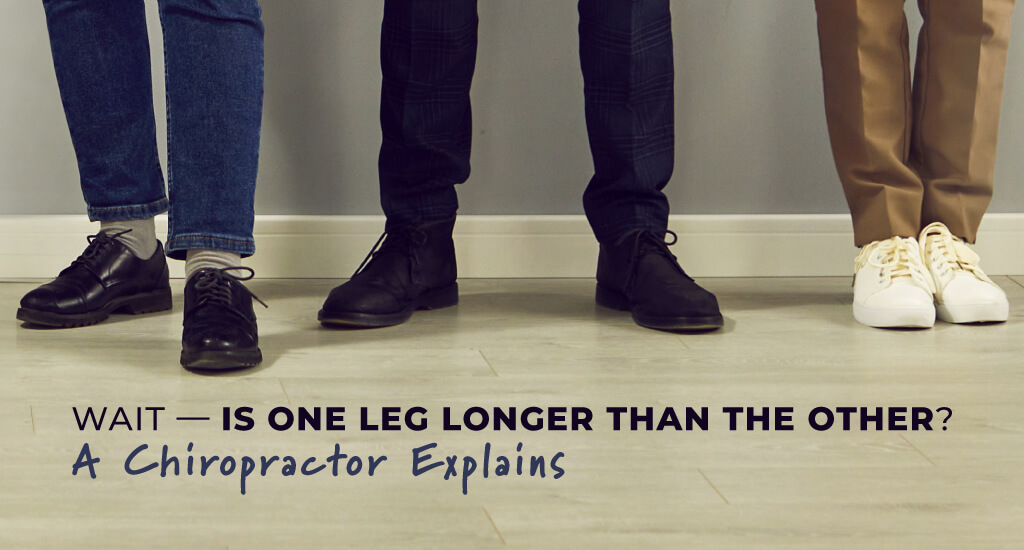
What Causes Back Pain? 7 Surprising Reasons
Before jumping to more serious conclusions, screen yourself for these 7 surprising causes of back pain that may be less obvious, but just as significant for understanding and managing your pain.

Have you ever noticed that the bottom hem of one pant leg is worn and frayed while the other stays perfectly intact? Or that the sole of your right shoe is always wearing out faster than the left? You may have concluded that one leg is longer than the other. Healthcare providers call this leg length discrepancy (LLD), and you’re not alone — 40–70% of us has it to some degree.
Is it noticeable to others? To what degree is one leg longer than the other? Length differences can range from a fraction of an inch to several inches, but people won’t usually notice until the condition causes you to limp. The more discrepancy, the more likely you are to have issues with pain, posture, and unbalanced gait.
In some cases, leg length discrepancy is anatomical — the bones of the lower leg (the tibia and femur) have measurably different lengths due to a birth defect, bone or growth plate injury or a joint replacement surgery. However, most leg length discrepancy is functional — it’s a result of how you’re using your body.
Our most overused muscles tend to become chronically tight because we adopt an imbalanced movement pattern that weakens them, causing poor joint mechanics, abnormal spine curvature and misalignment. This can put quite a damper on our lifestyle and wellness goals.
Your musculoskeletal system is like a connected pulley network. When one part shifts out of alignment, the rest of your body adjusts to balance you out. Leaning constantly on one hip, for example, shifts other body parts and joints of alignment. Although our bones are usually equal in length, functional leg length discrepancy causes one leg to appear longer when really, it’s just a misalignment in your pelvis, hip, knee, ankle, or foot.
Functional leg length discrepancy causes one leg to appear longer than the other when really, it’s just a misalignment in your pelvis, hip, knee, ankle, or foot.
If your leg length discrepancy is minuscule, you may not feel any symptoms. However, the National Library of Medicine found that even a 2-centimeter difference can force your pelvis to compensate for posture imbalance. Because they force you to work harder to maintain your balance, moderate-to-severe cases may cause:
As they intensify, these symptoms can severely impact your quality of life, so figuring out why you’re struggling with them and how to resolve them should be a priority.
If you take our One Leg Longer Than the Other test, then discuss the results with your chiropractor so you can understand the causes, symptoms and treatments for leg length discrepancy. Then you’ll spend less time wondering: ‘Can one leg be longer than the other?’ and more time seeking and understanding your diagnosis.
Some doctors diagnose leg length discrepancy as lateral pelvic tilt or pelvic torsion. That’s because its root cause is often chronic tightness in the core muscles that laterally tilt our pelvis and keep our core stable (the quadratus lumborum, obliques, and iliopsoas).
When your iliopsoa muscles are tight and weak from overflexing ,your quadratus lumborum muscles become tight and weak from trying so hard to bring the body back to normal posture. Leg length discrepancy can also cause other back muscles that bend your spine laterally (from side to one side) to tighten up too.
When you hike your right hip up, for example, you shift your weight to your left side, and your left rib cage gets pulled down toward your left hip. This also tightens up the muscles on the left side of your waist, left lower back and left hip. They’ll pull your rib cage downward instead of hiking your hip up.
When you notice that one leg is longer than the other it could be due to:
Whatever the root cause, once you’ve learned how to release the chronic tightness in your obliques and my iliopsoas, your hips will even out, your pain subside, and all of a sudden, your legs be the same length again!
Before getting a formal diagnosis from your Doctor of Chiropractic you may want to grab a friend and do a quick One Leg Longer Than the Other Test:
If they are not even, find a reputable chiropractor who can apply a more thorough test and diagnose your misalignment.
After a thorough exam, which may include an xray, your Doctor of Chiropractic will determine how much misalignment is impacting your pelvis and other joints. Then, specific chiropractic adjustments will be delivered to the spine, hip, pelvis, legs and feet along with soft tissue therapy. These therapies can immediately begin to resolve functional leg length discrepancies by:
To maintain the effects of those adjustments, your DC will also prescribe in-clinic supervised active therapies to gradually release your tight muscles more and more with each visit. Finally, if the severity of your leg length discrepancy requires it, you will be prescribe orthotics to help support fallen arches, knocked knees, a rotated hip or pelvis return to normal alignment and function.
Check in with your nearest Chiro One doc at one of our welcoming open-plan clinics across the country. They’ll perform a thorough exam to investigate the root cause of your pain, then personalize your care plan — a combination of gentle chiropractic adjustments and active therapies to get you feeling better longer. Find a Chiro One doctor near you.
Subscribe and get news, articles & offers sent right to your inbox each month.
"*" indicates required fields
By subscribing you are agreeing to the Terms and Conditions and Privacy Policy.